Business Environment: M&S, Tesco, NHS - Legal Structure and Analysis
VerifiedAdded on 2020/07/23
|13
|4441
|35
Report
AI Summary
This report provides a comprehensive analysis of the business environments of Marks & Spencer (M&S), Tesco, and the National Health Service (NHS). It begins by differentiating between private, public, and voluntary organizations, outlining their legal structures, and discussing the size and scope of each entity. The report then delves into the relationship between various functions within M&S, highlighting its flat organizational structure and the importance of departmental collaboration. A significant portion of the report is dedicated to PESTLE and SWOT analyses of M&S, examining political, economic, social, technological, legal, and environmental factors, as well as the company's strengths, weaknesses, opportunities, and threats. Finally, it explores the interrelation between internal and external factors influencing the business environment, concluding with a synthesis of the key findings and their implications for strategic decision-making.
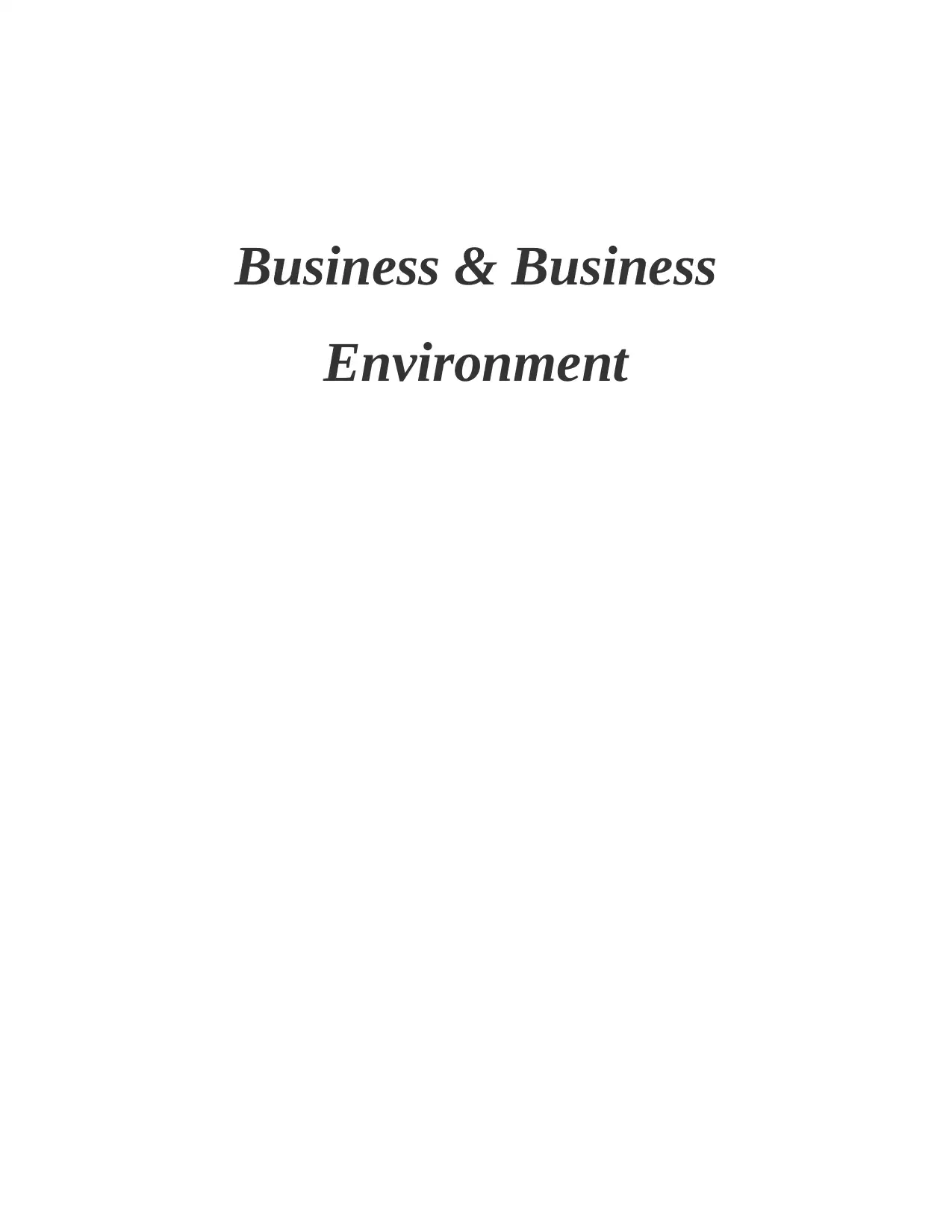
Business & Business
Environment
Environment
Paraphrase This Document
Need a fresh take? Get an instant paraphrase of this document with our AI Paraphraser
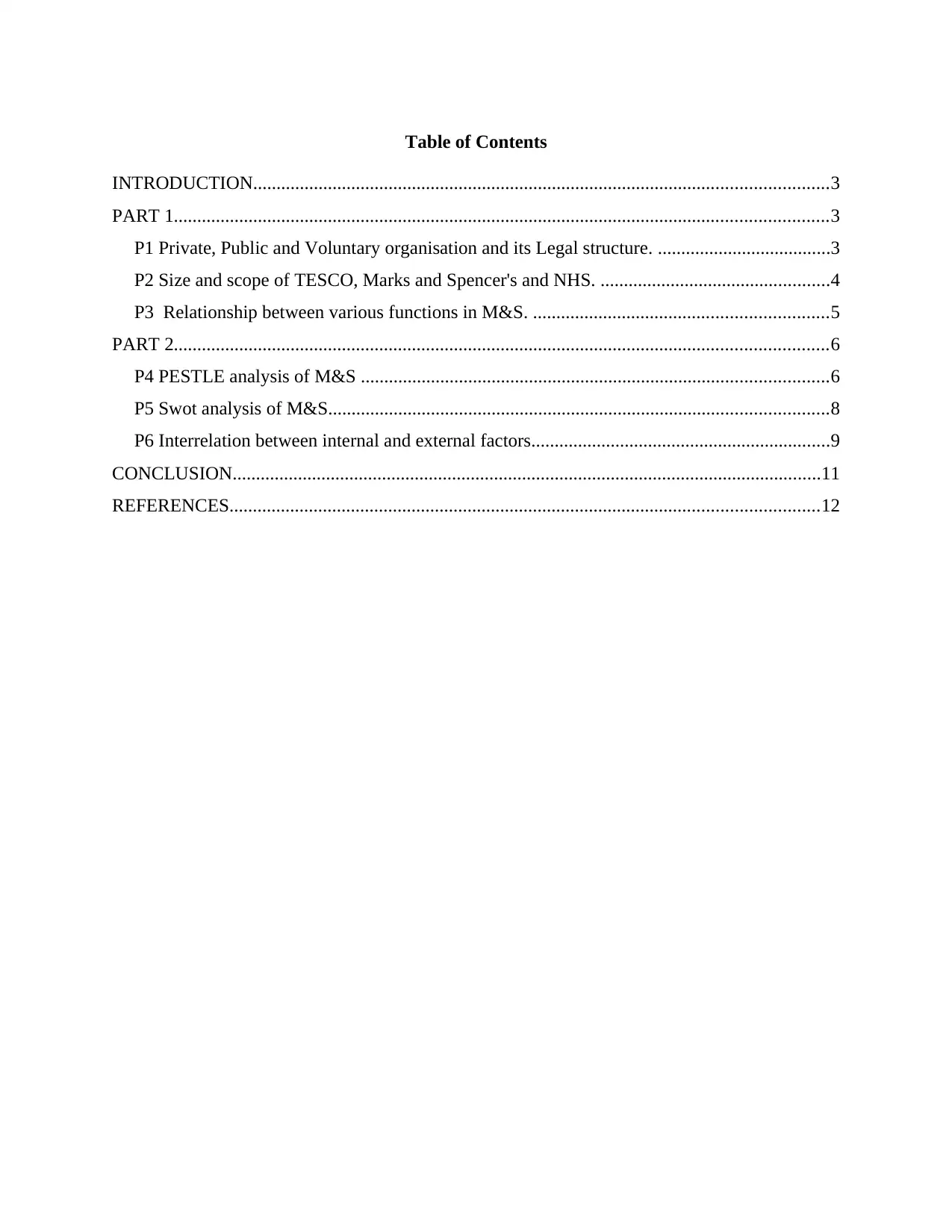
Table of Contents
INTRODUCTION...........................................................................................................................3
PART 1............................................................................................................................................3
P1 Private, Public and Voluntary organisation and its Legal structure. .....................................3
P2 Size and scope of TESCO, Marks and Spencer's and NHS. .................................................4
P3 Relationship between various functions in M&S. ...............................................................5
PART 2............................................................................................................................................6
P4 PESTLE analysis of M&S ....................................................................................................6
P5 Swot analysis of M&S...........................................................................................................8
P6 Interrelation between internal and external factors................................................................9
CONCLUSION..............................................................................................................................11
REFERENCES..............................................................................................................................12
INTRODUCTION...........................................................................................................................3
PART 1............................................................................................................................................3
P1 Private, Public and Voluntary organisation and its Legal structure. .....................................3
P2 Size and scope of TESCO, Marks and Spencer's and NHS. .................................................4
P3 Relationship between various functions in M&S. ...............................................................5
PART 2............................................................................................................................................6
P4 PESTLE analysis of M&S ....................................................................................................6
P5 Swot analysis of M&S...........................................................................................................8
P6 Interrelation between internal and external factors................................................................9
CONCLUSION..............................................................................................................................11
REFERENCES..............................................................................................................................12
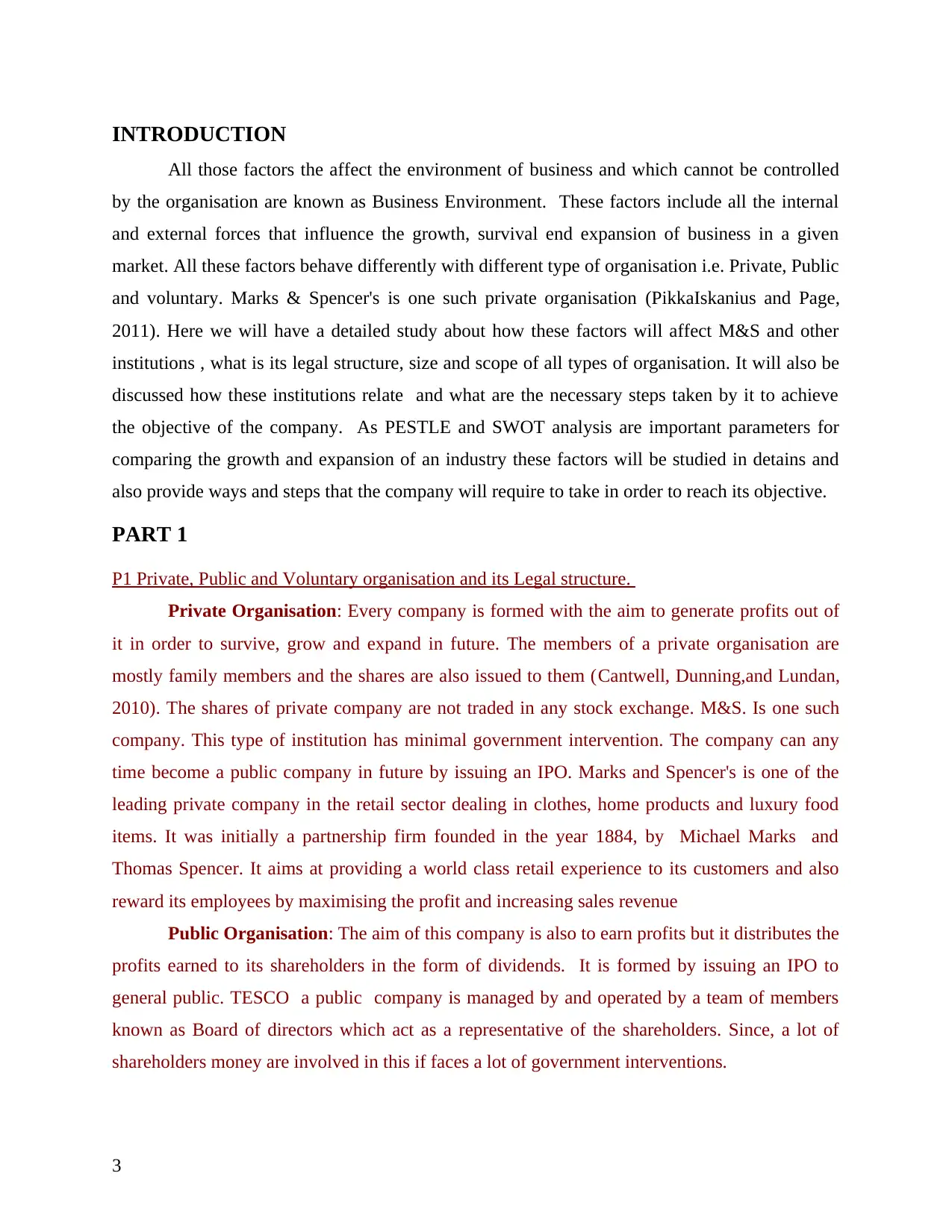
INTRODUCTION
All those factors the affect the environment of business and which cannot be controlled
by the organisation are known as Business Environment. These factors include all the internal
and external forces that influence the growth, survival end expansion of business in a given
market. All these factors behave differently with different type of organisation i.e. Private, Public
and voluntary. Marks & Spencer's is one such private organisation (PikkaIskanius and Page,
2011). Here we will have a detailed study about how these factors will affect M&S and other
institutions , what is its legal structure, size and scope of all types of organisation. It will also be
discussed how these institutions relate and what are the necessary steps taken by it to achieve
the objective of the company. As PESTLE and SWOT analysis are important parameters for
comparing the growth and expansion of an industry these factors will be studied in detains and
also provide ways and steps that the company will require to take in order to reach its objective.
PART 1
P1 Private, Public and Voluntary organisation and its Legal structure.
Private Organisation: Every company is formed with the aim to generate profits out of
it in order to survive, grow and expand in future. The members of a private organisation are
mostly family members and the shares are also issued to them (Cantwell, Dunning,and Lundan,
2010). The shares of private company are not traded in any stock exchange. M&S. Is one such
company. This type of institution has minimal government intervention. The company can any
time become a public company in future by issuing an IPO. Marks and Spencer's is one of the
leading private company in the retail sector dealing in clothes, home products and luxury food
items. It was initially a partnership firm founded in the year 1884, by Michael Marks and
Thomas Spencer. It aims at providing a world class retail experience to its customers and also
reward its employees by maximising the profit and increasing sales revenue
Public Organisation: The aim of this company is also to earn profits but it distributes the
profits earned to its shareholders in the form of dividends. It is formed by issuing an IPO to
general public. TESCO a public company is managed by and operated by a team of members
known as Board of directors which act as a representative of the shareholders. Since, a lot of
shareholders money are involved in this if faces a lot of government interventions.
3
All those factors the affect the environment of business and which cannot be controlled
by the organisation are known as Business Environment. These factors include all the internal
and external forces that influence the growth, survival end expansion of business in a given
market. All these factors behave differently with different type of organisation i.e. Private, Public
and voluntary. Marks & Spencer's is one such private organisation (PikkaIskanius and Page,
2011). Here we will have a detailed study about how these factors will affect M&S and other
institutions , what is its legal structure, size and scope of all types of organisation. It will also be
discussed how these institutions relate and what are the necessary steps taken by it to achieve
the objective of the company. As PESTLE and SWOT analysis are important parameters for
comparing the growth and expansion of an industry these factors will be studied in detains and
also provide ways and steps that the company will require to take in order to reach its objective.
PART 1
P1 Private, Public and Voluntary organisation and its Legal structure.
Private Organisation: Every company is formed with the aim to generate profits out of
it in order to survive, grow and expand in future. The members of a private organisation are
mostly family members and the shares are also issued to them (Cantwell, Dunning,and Lundan,
2010). The shares of private company are not traded in any stock exchange. M&S. Is one such
company. This type of institution has minimal government intervention. The company can any
time become a public company in future by issuing an IPO. Marks and Spencer's is one of the
leading private company in the retail sector dealing in clothes, home products and luxury food
items. It was initially a partnership firm founded in the year 1884, by Michael Marks and
Thomas Spencer. It aims at providing a world class retail experience to its customers and also
reward its employees by maximising the profit and increasing sales revenue
Public Organisation: The aim of this company is also to earn profits but it distributes the
profits earned to its shareholders in the form of dividends. It is formed by issuing an IPO to
general public. TESCO a public company is managed by and operated by a team of members
known as Board of directors which act as a representative of the shareholders. Since, a lot of
shareholders money are involved in this if faces a lot of government interventions.
3
⊘ This is a preview!⊘
Do you want full access?
Subscribe today to unlock all pages.

Trusted by 1+ million students worldwide
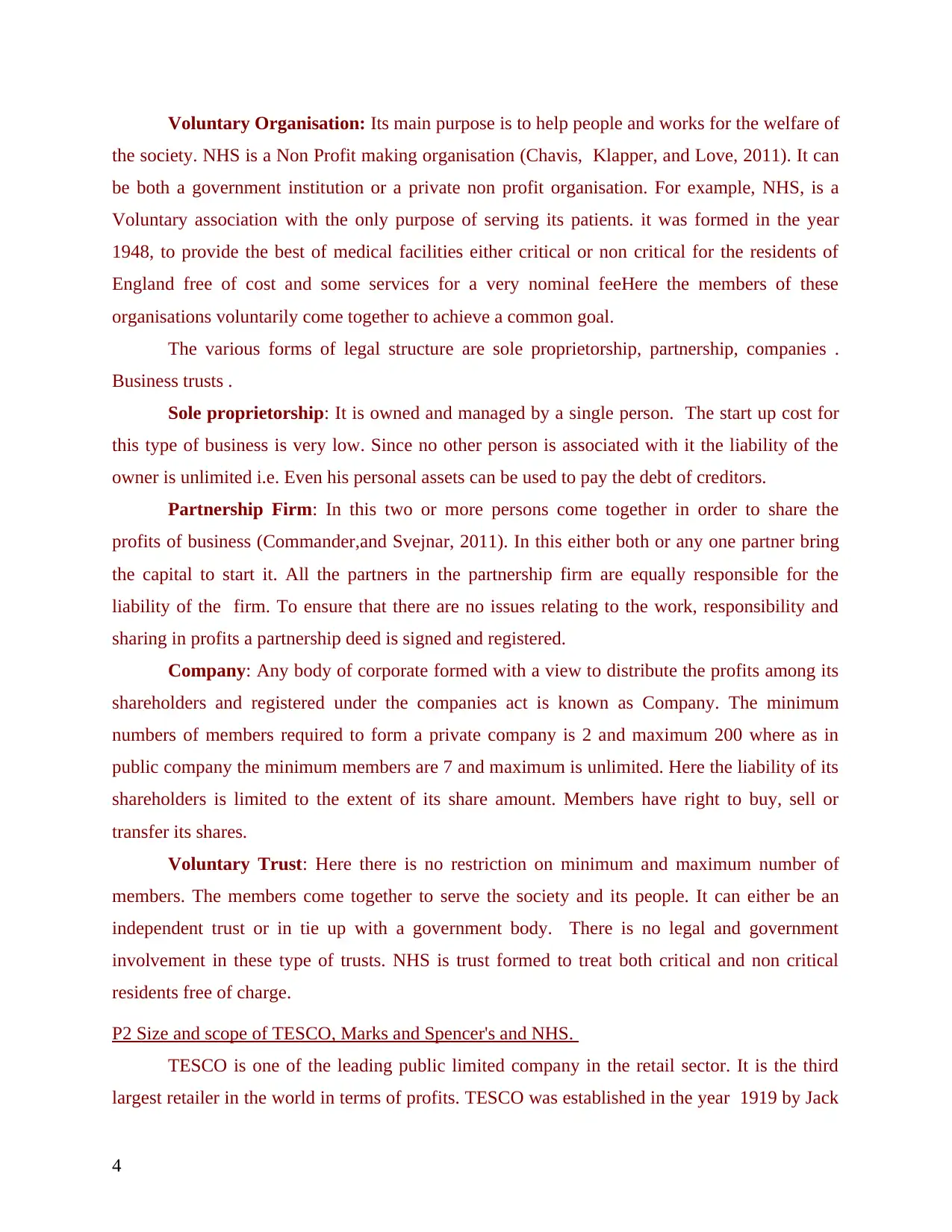
Voluntary Organisation: Its main purpose is to help people and works for the welfare of
the society. NHS is a Non Profit making organisation (Chavis, Klapper, and Love, 2011). It can
be both a government institution or a private non profit organisation. For example, NHS, is a
Voluntary association with the only purpose of serving its patients. it was formed in the year
1948, to provide the best of medical facilities either critical or non critical for the residents of
England free of cost and some services for a very nominal feeHere the members of these
organisations voluntarily come together to achieve a common goal.
The various forms of legal structure are sole proprietorship, partnership, companies .
Business trusts .
Sole proprietorship: It is owned and managed by a single person. The start up cost for
this type of business is very low. Since no other person is associated with it the liability of the
owner is unlimited i.e. Even his personal assets can be used to pay the debt of creditors.
Partnership Firm: In this two or more persons come together in order to share the
profits of business (Commander,and Svejnar, 2011). In this either both or any one partner bring
the capital to start it. All the partners in the partnership firm are equally responsible for the
liability of the firm. To ensure that there are no issues relating to the work, responsibility and
sharing in profits a partnership deed is signed and registered.
Company: Any body of corporate formed with a view to distribute the profits among its
shareholders and registered under the companies act is known as Company. The minimum
numbers of members required to form a private company is 2 and maximum 200 where as in
public company the minimum members are 7 and maximum is unlimited. Here the liability of its
shareholders is limited to the extent of its share amount. Members have right to buy, sell or
transfer its shares.
Voluntary Trust: Here there is no restriction on minimum and maximum number of
members. The members come together to serve the society and its people. It can either be an
independent trust or in tie up with a government body. There is no legal and government
involvement in these type of trusts. NHS is trust formed to treat both critical and non critical
residents free of charge.
P2 Size and scope of TESCO, Marks and Spencer's and NHS.
TESCO is one of the leading public limited company in the retail sector. It is the third
largest retailer in the world in terms of profits. TESCO was established in the year 1919 by Jack
4
the society. NHS is a Non Profit making organisation (Chavis, Klapper, and Love, 2011). It can
be both a government institution or a private non profit organisation. For example, NHS, is a
Voluntary association with the only purpose of serving its patients. it was formed in the year
1948, to provide the best of medical facilities either critical or non critical for the residents of
England free of cost and some services for a very nominal feeHere the members of these
organisations voluntarily come together to achieve a common goal.
The various forms of legal structure are sole proprietorship, partnership, companies .
Business trusts .
Sole proprietorship: It is owned and managed by a single person. The start up cost for
this type of business is very low. Since no other person is associated with it the liability of the
owner is unlimited i.e. Even his personal assets can be used to pay the debt of creditors.
Partnership Firm: In this two or more persons come together in order to share the
profits of business (Commander,and Svejnar, 2011). In this either both or any one partner bring
the capital to start it. All the partners in the partnership firm are equally responsible for the
liability of the firm. To ensure that there are no issues relating to the work, responsibility and
sharing in profits a partnership deed is signed and registered.
Company: Any body of corporate formed with a view to distribute the profits among its
shareholders and registered under the companies act is known as Company. The minimum
numbers of members required to form a private company is 2 and maximum 200 where as in
public company the minimum members are 7 and maximum is unlimited. Here the liability of its
shareholders is limited to the extent of its share amount. Members have right to buy, sell or
transfer its shares.
Voluntary Trust: Here there is no restriction on minimum and maximum number of
members. The members come together to serve the society and its people. It can either be an
independent trust or in tie up with a government body. There is no legal and government
involvement in these type of trusts. NHS is trust formed to treat both critical and non critical
residents free of charge.
P2 Size and scope of TESCO, Marks and Spencer's and NHS.
TESCO is one of the leading public limited company in the retail sector. It is the third
largest retailer in the world in terms of profits. TESCO was established in the year 1919 by Jack
4
Paraphrase This Document
Need a fresh take? Get an instant paraphrase of this document with our AI Paraphraser
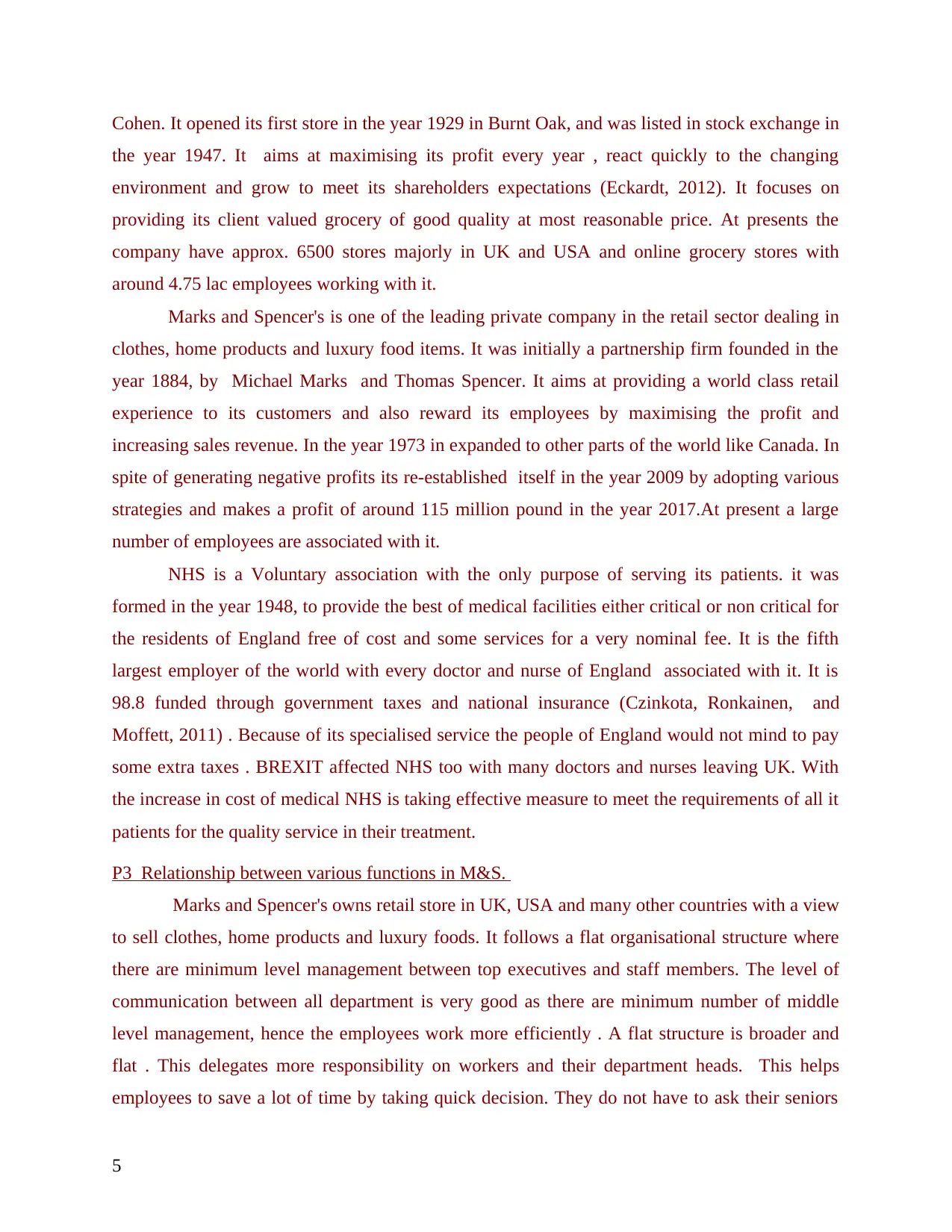
Cohen. It opened its first store in the year 1929 in Burnt Oak, and was listed in stock exchange in
the year 1947. It aims at maximising its profit every year , react quickly to the changing
environment and grow to meet its shareholders expectations (Eckardt, 2012). It focuses on
providing its client valued grocery of good quality at most reasonable price. At presents the
company have approx. 6500 stores majorly in UK and USA and online grocery stores with
around 4.75 lac employees working with it.
Marks and Spencer's is one of the leading private company in the retail sector dealing in
clothes, home products and luxury food items. It was initially a partnership firm founded in the
year 1884, by Michael Marks and Thomas Spencer. It aims at providing a world class retail
experience to its customers and also reward its employees by maximising the profit and
increasing sales revenue. In the year 1973 in expanded to other parts of the world like Canada. In
spite of generating negative profits its re-established itself in the year 2009 by adopting various
strategies and makes a profit of around 115 million pound in the year 2017.At present a large
number of employees are associated with it.
NHS is a Voluntary association with the only purpose of serving its patients. it was
formed in the year 1948, to provide the best of medical facilities either critical or non critical for
the residents of England free of cost and some services for a very nominal fee. It is the fifth
largest employer of the world with every doctor and nurse of England associated with it. It is
98.8 funded through government taxes and national insurance (Czinkota, Ronkainen, and
Moffett, 2011) . Because of its specialised service the people of England would not mind to pay
some extra taxes . BREXIT affected NHS too with many doctors and nurses leaving UK. With
the increase in cost of medical NHS is taking effective measure to meet the requirements of all it
patients for the quality service in their treatment.
P3 Relationship between various functions in M&S.
Marks and Spencer's owns retail store in UK, USA and many other countries with a view
to sell clothes, home products and luxury foods. It follows a flat organisational structure where
there are minimum level management between top executives and staff members. The level of
communication between all department is very good as there are minimum number of middle
level management, hence the employees work more efficiently . A flat structure is broader and
flat . This delegates more responsibility on workers and their department heads. This helps
employees to save a lot of time by taking quick decision. They do not have to ask their seniors
5
the year 1947. It aims at maximising its profit every year , react quickly to the changing
environment and grow to meet its shareholders expectations (Eckardt, 2012). It focuses on
providing its client valued grocery of good quality at most reasonable price. At presents the
company have approx. 6500 stores majorly in UK and USA and online grocery stores with
around 4.75 lac employees working with it.
Marks and Spencer's is one of the leading private company in the retail sector dealing in
clothes, home products and luxury food items. It was initially a partnership firm founded in the
year 1884, by Michael Marks and Thomas Spencer. It aims at providing a world class retail
experience to its customers and also reward its employees by maximising the profit and
increasing sales revenue. In the year 1973 in expanded to other parts of the world like Canada. In
spite of generating negative profits its re-established itself in the year 2009 by adopting various
strategies and makes a profit of around 115 million pound in the year 2017.At present a large
number of employees are associated with it.
NHS is a Voluntary association with the only purpose of serving its patients. it was
formed in the year 1948, to provide the best of medical facilities either critical or non critical for
the residents of England free of cost and some services for a very nominal fee. It is the fifth
largest employer of the world with every doctor and nurse of England associated with it. It is
98.8 funded through government taxes and national insurance (Czinkota, Ronkainen, and
Moffett, 2011) . Because of its specialised service the people of England would not mind to pay
some extra taxes . BREXIT affected NHS too with many doctors and nurses leaving UK. With
the increase in cost of medical NHS is taking effective measure to meet the requirements of all it
patients for the quality service in their treatment.
P3 Relationship between various functions in M&S.
Marks and Spencer's owns retail store in UK, USA and many other countries with a view
to sell clothes, home products and luxury foods. It follows a flat organisational structure where
there are minimum level management between top executives and staff members. The level of
communication between all department is very good as there are minimum number of middle
level management, hence the employees work more efficiently . A flat structure is broader and
flat . This delegates more responsibility on workers and their department heads. This helps
employees to save a lot of time by taking quick decision. They do not have to ask their seniors
5
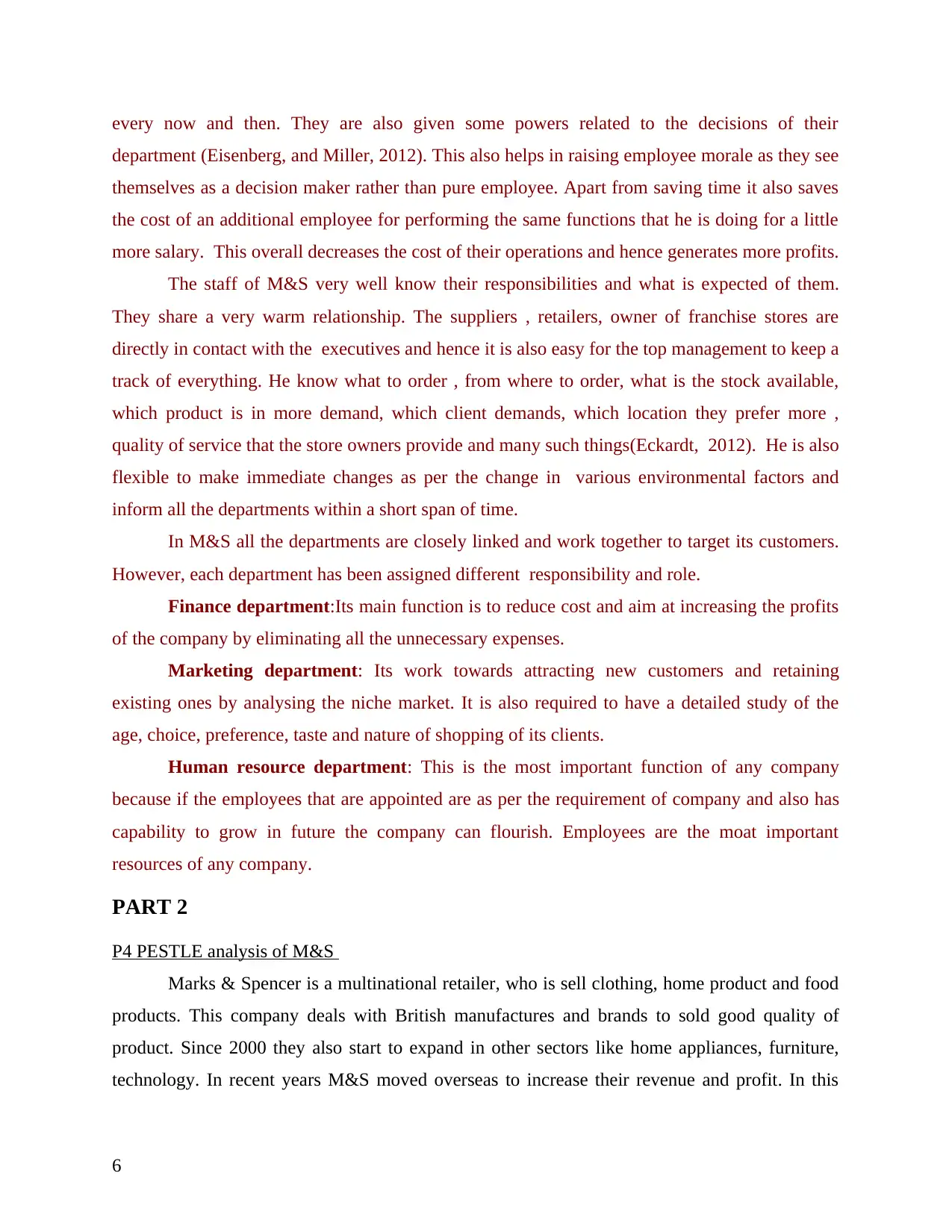
every now and then. They are also given some powers related to the decisions of their
department (Eisenberg, and Miller, 2012). This also helps in raising employee morale as they see
themselves as a decision maker rather than pure employee. Apart from saving time it also saves
the cost of an additional employee for performing the same functions that he is doing for a little
more salary. This overall decreases the cost of their operations and hence generates more profits.
The staff of M&S very well know their responsibilities and what is expected of them.
They share a very warm relationship. The suppliers , retailers, owner of franchise stores are
directly in contact with the executives and hence it is also easy for the top management to keep a
track of everything. He know what to order , from where to order, what is the stock available,
which product is in more demand, which client demands, which location they prefer more ,
quality of service that the store owners provide and many such things(Eckardt, 2012). He is also
flexible to make immediate changes as per the change in various environmental factors and
inform all the departments within a short span of time.
In M&S all the departments are closely linked and work together to target its customers.
However, each department has been assigned different responsibility and role.
Finance department:Its main function is to reduce cost and aim at increasing the profits
of the company by eliminating all the unnecessary expenses.
Marketing department: Its work towards attracting new customers and retaining
existing ones by analysing the niche market. It is also required to have a detailed study of the
age, choice, preference, taste and nature of shopping of its clients.
Human resource department: This is the most important function of any company
because if the employees that are appointed are as per the requirement of company and also has
capability to grow in future the company can flourish. Employees are the moat important
resources of any company.
PART 2
P4 PESTLE analysis of M&S
Marks & Spencer is a multinational retailer, who is sell clothing, home product and food
products. This company deals with British manufactures and brands to sold good quality of
product. Since 2000 they also start to expand in other sectors like home appliances, furniture,
technology. In recent years M&S moved overseas to increase their revenue and profit. In this
6
department (Eisenberg, and Miller, 2012). This also helps in raising employee morale as they see
themselves as a decision maker rather than pure employee. Apart from saving time it also saves
the cost of an additional employee for performing the same functions that he is doing for a little
more salary. This overall decreases the cost of their operations and hence generates more profits.
The staff of M&S very well know their responsibilities and what is expected of them.
They share a very warm relationship. The suppliers , retailers, owner of franchise stores are
directly in contact with the executives and hence it is also easy for the top management to keep a
track of everything. He know what to order , from where to order, what is the stock available,
which product is in more demand, which client demands, which location they prefer more ,
quality of service that the store owners provide and many such things(Eckardt, 2012). He is also
flexible to make immediate changes as per the change in various environmental factors and
inform all the departments within a short span of time.
In M&S all the departments are closely linked and work together to target its customers.
However, each department has been assigned different responsibility and role.
Finance department:Its main function is to reduce cost and aim at increasing the profits
of the company by eliminating all the unnecessary expenses.
Marketing department: Its work towards attracting new customers and retaining
existing ones by analysing the niche market. It is also required to have a detailed study of the
age, choice, preference, taste and nature of shopping of its clients.
Human resource department: This is the most important function of any company
because if the employees that are appointed are as per the requirement of company and also has
capability to grow in future the company can flourish. Employees are the moat important
resources of any company.
PART 2
P4 PESTLE analysis of M&S
Marks & Spencer is a multinational retailer, who is sell clothing, home product and food
products. This company deals with British manufactures and brands to sold good quality of
product. Since 2000 they also start to expand in other sectors like home appliances, furniture,
technology. In recent years M&S moved overseas to increase their revenue and profit. In this
6
⊘ This is a preview!⊘
Do you want full access?
Subscribe today to unlock all pages.

Trusted by 1+ million students worldwide
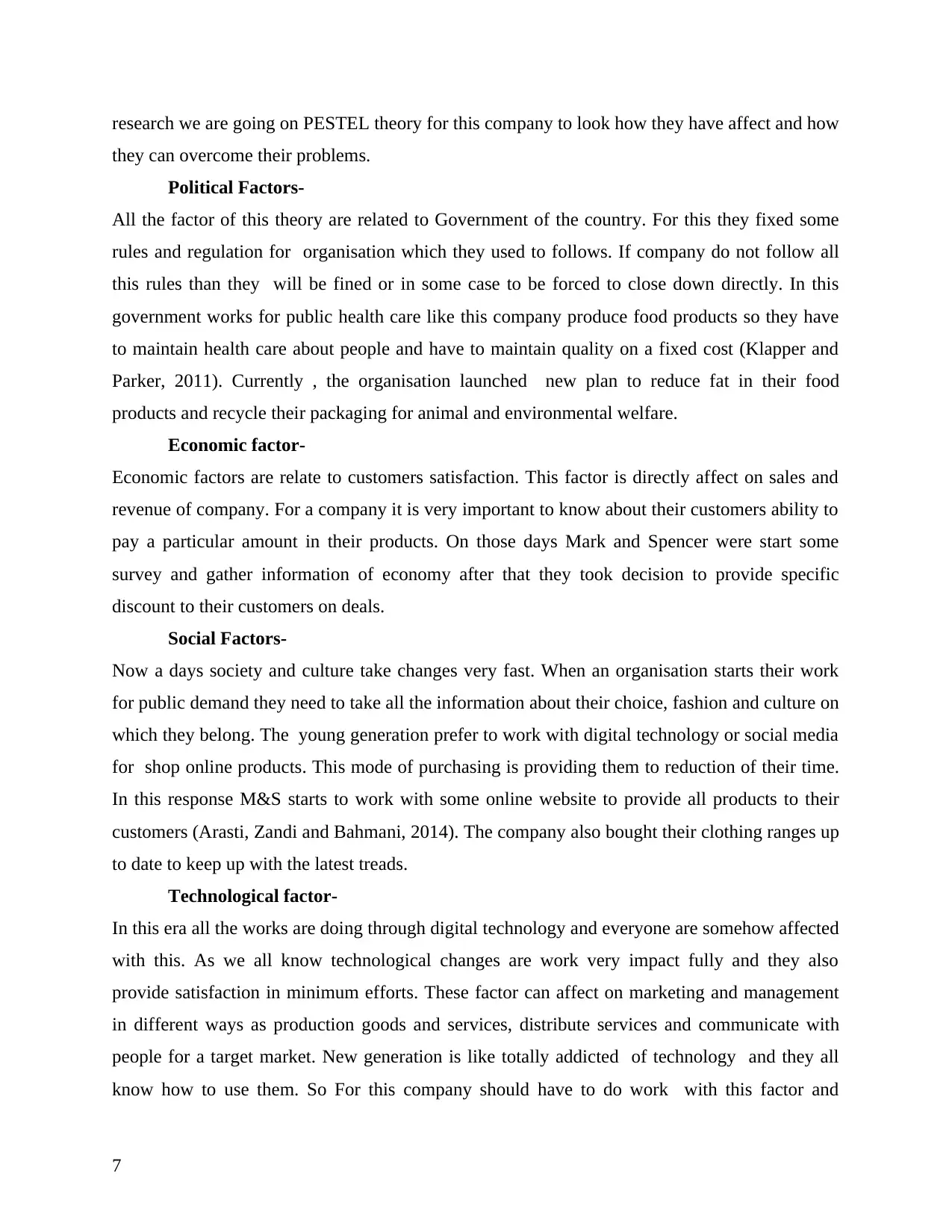
research we are going on PESTEL theory for this company to look how they have affect and how
they can overcome their problems.
Political Factors-
All the factor of this theory are related to Government of the country. For this they fixed some
rules and regulation for organisation which they used to follows. If company do not follow all
this rules than they will be fined or in some case to be forced to close down directly. In this
government works for public health care like this company produce food products so they have
to maintain health care about people and have to maintain quality on a fixed cost (Klapper and
Parker, 2011). Currently , the organisation launched new plan to reduce fat in their food
products and recycle their packaging for animal and environmental welfare.
Economic factor-
Economic factors are relate to customers satisfaction. This factor is directly affect on sales and
revenue of company. For a company it is very important to know about their customers ability to
pay a particular amount in their products. On those days Mark and Spencer were start some
survey and gather information of economy after that they took decision to provide specific
discount to their customers on deals.
Social Factors-
Now a days society and culture take changes very fast. When an organisation starts their work
for public demand they need to take all the information about their choice, fashion and culture on
which they belong. The young generation prefer to work with digital technology or social media
for shop online products. This mode of purchasing is providing them to reduction of their time.
In this response M&S starts to work with some online website to provide all products to their
customers (Arasti, Zandi and Bahmani, 2014). The company also bought their clothing ranges up
to date to keep up with the latest treads.
Technological factor-
In this era all the works are doing through digital technology and everyone are somehow affected
with this. As we all know technological changes are work very impact fully and they also
provide satisfaction in minimum efforts. These factor can affect on marketing and management
in different ways as production goods and services, distribute services and communicate with
people for a target market. New generation is like totally addicted of technology and they all
know how to use them. So For this company should have to do work with this factor and
7
they can overcome their problems.
Political Factors-
All the factor of this theory are related to Government of the country. For this they fixed some
rules and regulation for organisation which they used to follows. If company do not follow all
this rules than they will be fined or in some case to be forced to close down directly. In this
government works for public health care like this company produce food products so they have
to maintain health care about people and have to maintain quality on a fixed cost (Klapper and
Parker, 2011). Currently , the organisation launched new plan to reduce fat in their food
products and recycle their packaging for animal and environmental welfare.
Economic factor-
Economic factors are relate to customers satisfaction. This factor is directly affect on sales and
revenue of company. For a company it is very important to know about their customers ability to
pay a particular amount in their products. On those days Mark and Spencer were start some
survey and gather information of economy after that they took decision to provide specific
discount to their customers on deals.
Social Factors-
Now a days society and culture take changes very fast. When an organisation starts their work
for public demand they need to take all the information about their choice, fashion and culture on
which they belong. The young generation prefer to work with digital technology or social media
for shop online products. This mode of purchasing is providing them to reduction of their time.
In this response M&S starts to work with some online website to provide all products to their
customers (Arasti, Zandi and Bahmani, 2014). The company also bought their clothing ranges up
to date to keep up with the latest treads.
Technological factor-
In this era all the works are doing through digital technology and everyone are somehow affected
with this. As we all know technological changes are work very impact fully and they also
provide satisfaction in minimum efforts. These factor can affect on marketing and management
in different ways as production goods and services, distribute services and communicate with
people for a target market. New generation is like totally addicted of technology and they all
know how to use them. So For this company should have to do work with this factor and
7
Paraphrase This Document
Need a fresh take? Get an instant paraphrase of this document with our AI Paraphraser
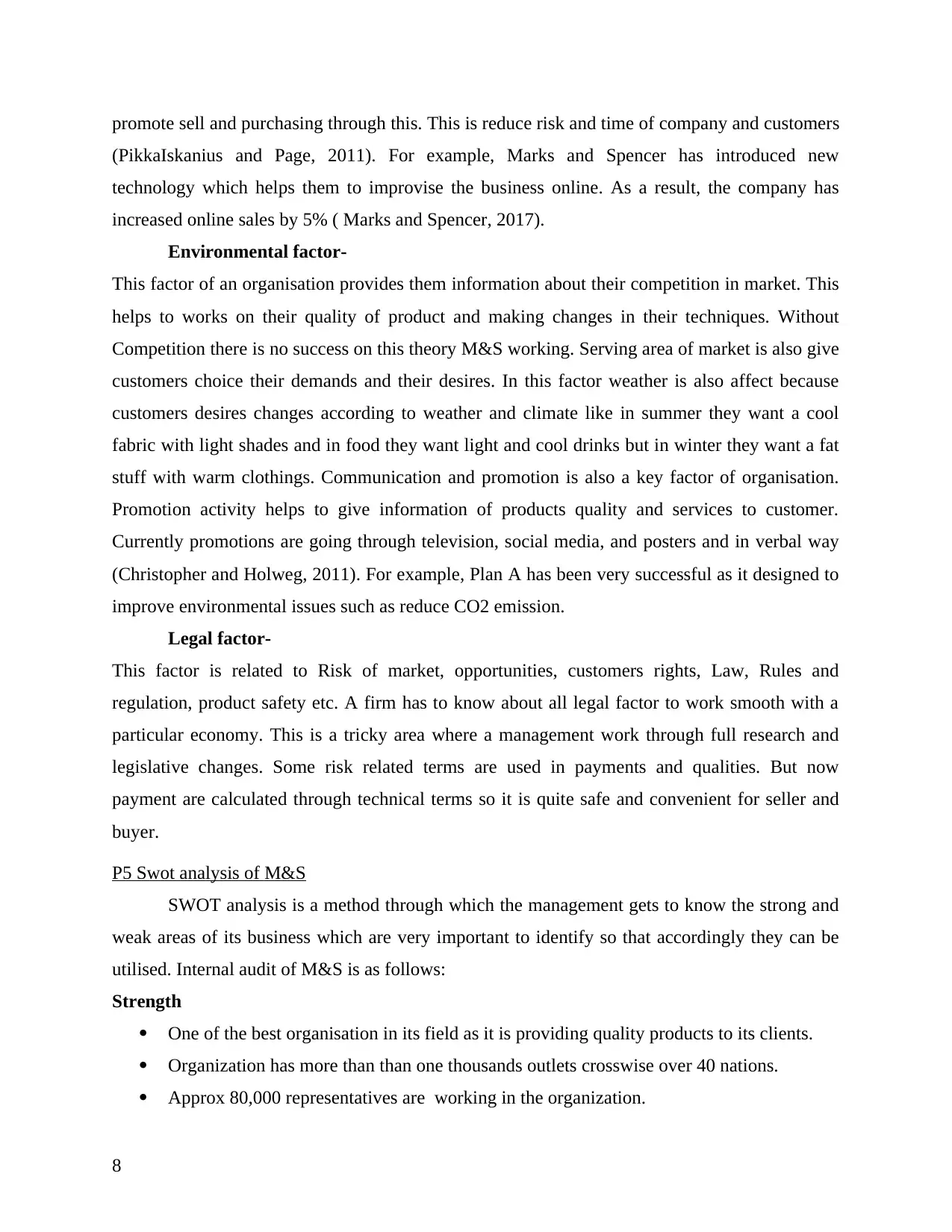
promote sell and purchasing through this. This is reduce risk and time of company and customers
(PikkaIskanius and Page, 2011). For example, Marks and Spencer has introduced new
technology which helps them to improvise the business online. As a result, the company has
increased online sales by 5% ( Marks and Spencer, 2017).
Environmental factor-
This factor of an organisation provides them information about their competition in market. This
helps to works on their quality of product and making changes in their techniques. Without
Competition there is no success on this theory M&S working. Serving area of market is also give
customers choice their demands and their desires. In this factor weather is also affect because
customers desires changes according to weather and climate like in summer they want a cool
fabric with light shades and in food they want light and cool drinks but in winter they want a fat
stuff with warm clothings. Communication and promotion is also a key factor of organisation.
Promotion activity helps to give information of products quality and services to customer.
Currently promotions are going through television, social media, and posters and in verbal way
(Christopher and Holweg, 2011). For example, Plan A has been very successful as it designed to
improve environmental issues such as reduce CO2 emission.
Legal factor-
This factor is related to Risk of market, opportunities, customers rights, Law, Rules and
regulation, product safety etc. A firm has to know about all legal factor to work smooth with a
particular economy. This is a tricky area where a management work through full research and
legislative changes. Some risk related terms are used in payments and qualities. But now
payment are calculated through technical terms so it is quite safe and convenient for seller and
buyer.
P5 Swot analysis of M&S
SWOT analysis is a method through which the management gets to know the strong and
weak areas of its business which are very important to identify so that accordingly they can be
utilised. Internal audit of M&S is as follows:
Strength
One of the best organisation in its field as it is providing quality products to its clients.
Organization has more than than one thousands outlets crosswise over 40 nations.
Approx 80,000 representatives are working in the organization.
8
(PikkaIskanius and Page, 2011). For example, Marks and Spencer has introduced new
technology which helps them to improvise the business online. As a result, the company has
increased online sales by 5% ( Marks and Spencer, 2017).
Environmental factor-
This factor of an organisation provides them information about their competition in market. This
helps to works on their quality of product and making changes in their techniques. Without
Competition there is no success on this theory M&S working. Serving area of market is also give
customers choice their demands and their desires. In this factor weather is also affect because
customers desires changes according to weather and climate like in summer they want a cool
fabric with light shades and in food they want light and cool drinks but in winter they want a fat
stuff with warm clothings. Communication and promotion is also a key factor of organisation.
Promotion activity helps to give information of products quality and services to customer.
Currently promotions are going through television, social media, and posters and in verbal way
(Christopher and Holweg, 2011). For example, Plan A has been very successful as it designed to
improve environmental issues such as reduce CO2 emission.
Legal factor-
This factor is related to Risk of market, opportunities, customers rights, Law, Rules and
regulation, product safety etc. A firm has to know about all legal factor to work smooth with a
particular economy. This is a tricky area where a management work through full research and
legislative changes. Some risk related terms are used in payments and qualities. But now
payment are calculated through technical terms so it is quite safe and convenient for seller and
buyer.
P5 Swot analysis of M&S
SWOT analysis is a method through which the management gets to know the strong and
weak areas of its business which are very important to identify so that accordingly they can be
utilised. Internal audit of M&S is as follows:
Strength
One of the best organisation in its field as it is providing quality products to its clients.
Organization has more than than one thousands outlets crosswise over 40 nations.
Approx 80,000 representatives are working in the organization.
8
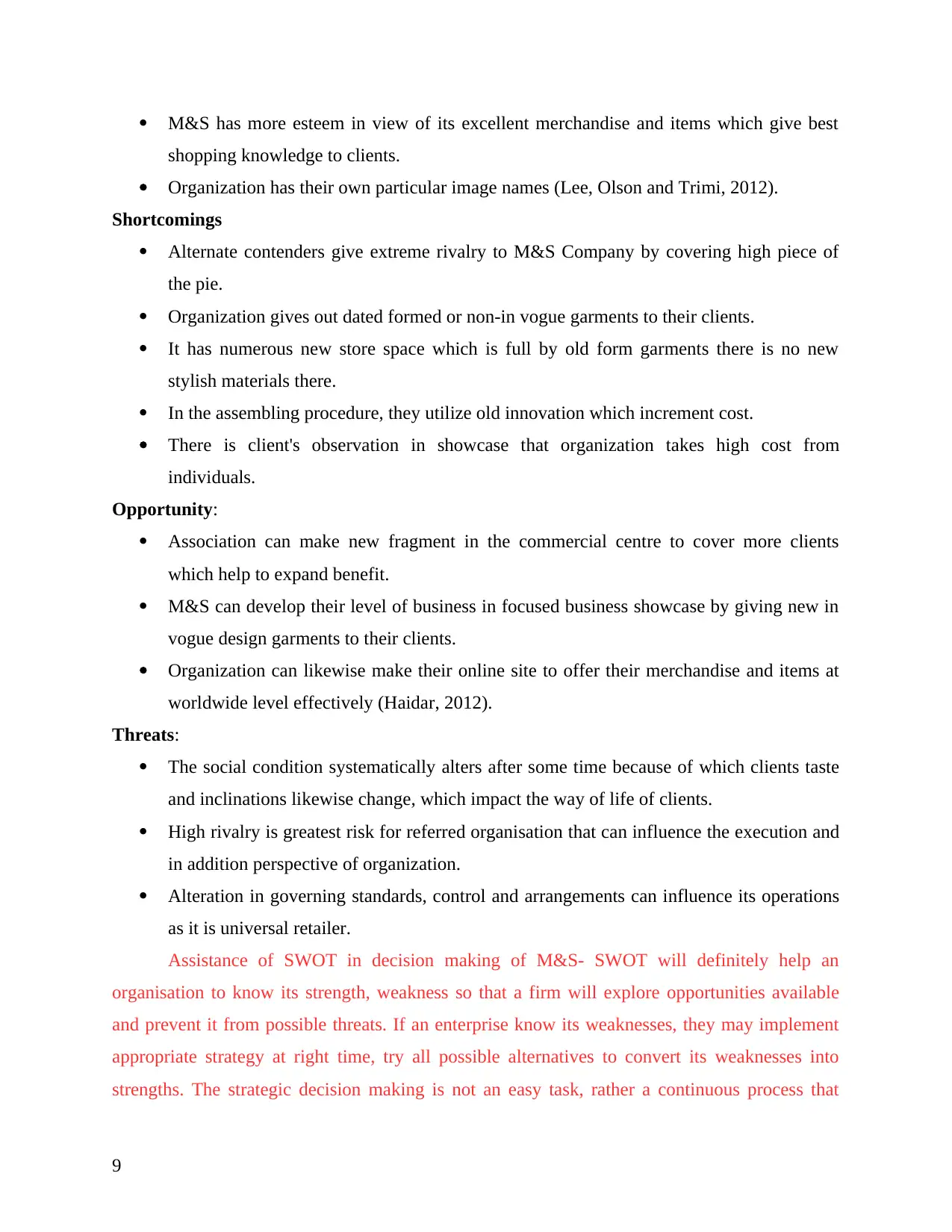
M&S has more esteem in view of its excellent merchandise and items which give best
shopping knowledge to clients.
Organization has their own particular image names (Lee, Olson and Trimi, 2012).
Shortcomings
Alternate contenders give extreme rivalry to M&S Company by covering high piece of
the pie.
Organization gives out dated formed or non-in vogue garments to their clients.
It has numerous new store space which is full by old form garments there is no new
stylish materials there.
In the assembling procedure, they utilize old innovation which increment cost.
There is client's observation in showcase that organization takes high cost from
individuals.
Opportunity:
Association can make new fragment in the commercial centre to cover more clients
which help to expand benefit.
M&S can develop their level of business in focused business showcase by giving new in
vogue design garments to their clients.
Organization can likewise make their online site to offer their merchandise and items at
worldwide level effectively (Haidar, 2012).
Threats:
The social condition systematically alters after some time because of which clients taste
and inclinations likewise change, which impact the way of life of clients.
High rivalry is greatest risk for referred organisation that can influence the execution and
in addition perspective of organization.
Alteration in governing standards, control and arrangements can influence its operations
as it is universal retailer.
Assistance of SWOT in decision making of M&S- SWOT will definitely help an
organisation to know its strength, weakness so that a firm will explore opportunities available
and prevent it from possible threats. If an enterprise know its weaknesses, they may implement
appropriate strategy at right time, try all possible alternatives to convert its weaknesses into
strengths. The strategic decision making is not an easy task, rather a continuous process that
9
shopping knowledge to clients.
Organization has their own particular image names (Lee, Olson and Trimi, 2012).
Shortcomings
Alternate contenders give extreme rivalry to M&S Company by covering high piece of
the pie.
Organization gives out dated formed or non-in vogue garments to their clients.
It has numerous new store space which is full by old form garments there is no new
stylish materials there.
In the assembling procedure, they utilize old innovation which increment cost.
There is client's observation in showcase that organization takes high cost from
individuals.
Opportunity:
Association can make new fragment in the commercial centre to cover more clients
which help to expand benefit.
M&S can develop their level of business in focused business showcase by giving new in
vogue design garments to their clients.
Organization can likewise make their online site to offer their merchandise and items at
worldwide level effectively (Haidar, 2012).
Threats:
The social condition systematically alters after some time because of which clients taste
and inclinations likewise change, which impact the way of life of clients.
High rivalry is greatest risk for referred organisation that can influence the execution and
in addition perspective of organization.
Alteration in governing standards, control and arrangements can influence its operations
as it is universal retailer.
Assistance of SWOT in decision making of M&S- SWOT will definitely help an
organisation to know its strength, weakness so that a firm will explore opportunities available
and prevent it from possible threats. If an enterprise know its weaknesses, they may implement
appropriate strategy at right time, try all possible alternatives to convert its weaknesses into
strengths. The strategic decision making is not an easy task, rather a continuous process that
9
⊘ This is a preview!⊘
Do you want full access?
Subscribe today to unlock all pages.

Trusted by 1+ million students worldwide
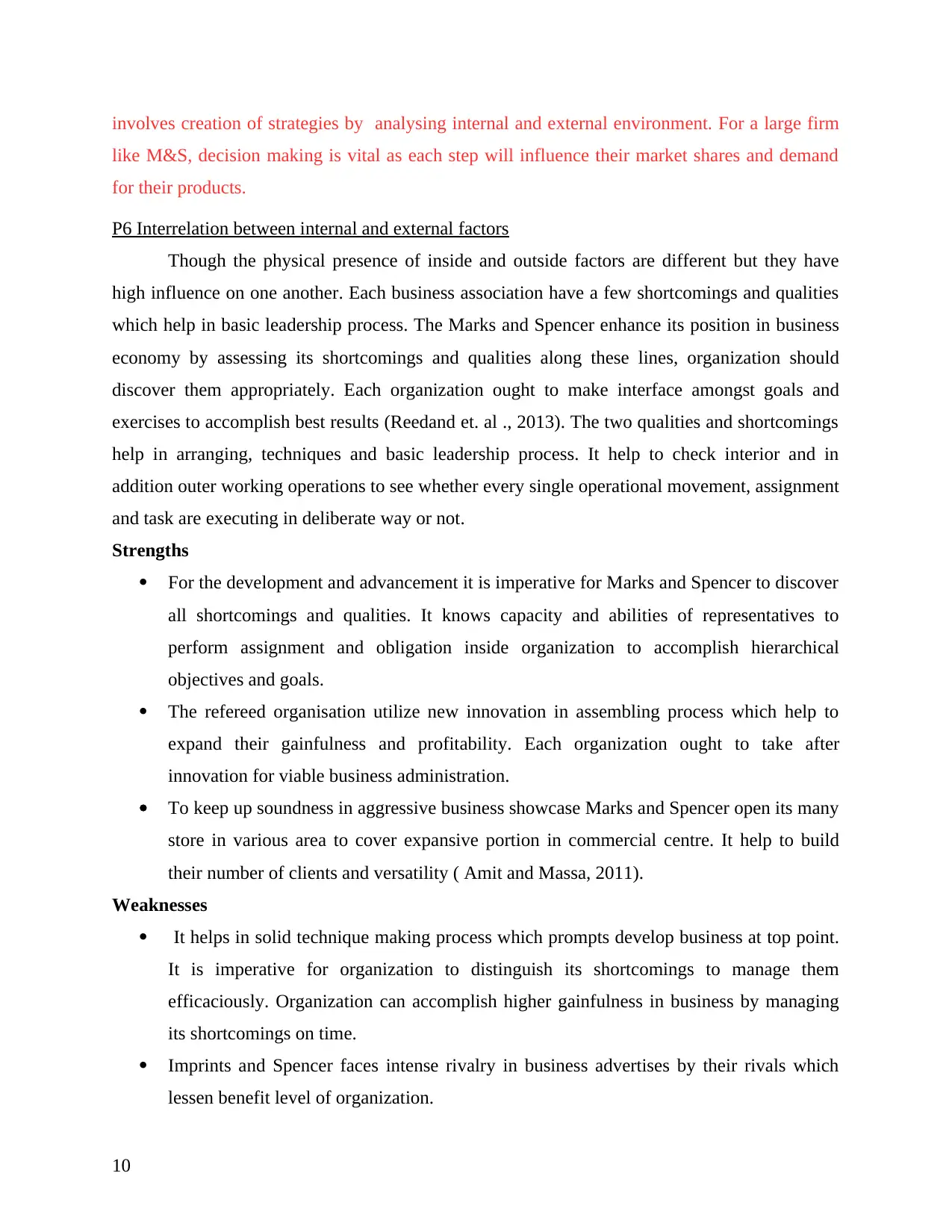
involves creation of strategies by analysing internal and external environment. For a large firm
like M&S, decision making is vital as each step will influence their market shares and demand
for their products.
P6 Interrelation between internal and external factors
Though the physical presence of inside and outside factors are different but they have
high influence on one another. Each business association have a few shortcomings and qualities
which help in basic leadership process. The Marks and Spencer enhance its position in business
economy by assessing its shortcomings and qualities along these lines, organization should
discover them appropriately. Each organization ought to make interface amongst goals and
exercises to accomplish best results (Reedand et. al ., 2013). The two qualities and shortcomings
help in arranging, techniques and basic leadership process. It help to check interior and in
addition outer working operations to see whether every single operational movement, assignment
and task are executing in deliberate way or not.
Strengths
For the development and advancement it is imperative for Marks and Spencer to discover
all shortcomings and qualities. It knows capacity and abilities of representatives to
perform assignment and obligation inside organization to accomplish hierarchical
objectives and goals.
The refereed organisation utilize new innovation in assembling process which help to
expand their gainfulness and profitability. Each organization ought to take after
innovation for viable business administration.
To keep up soundness in aggressive business showcase Marks and Spencer open its many
store in various area to cover expansive portion in commercial centre. It help to build
their number of clients and versatility ( Amit and Massa, 2011).
Weaknesses
It helps in solid technique making process which prompts develop business at top point.
It is imperative for organization to distinguish its shortcomings to manage them
efficaciously. Organization can accomplish higher gainfulness in business by managing
its shortcomings on time.
Imprints and Spencer faces intense rivalry in business advertises by their rivals which
lessen benefit level of organization.
10
like M&S, decision making is vital as each step will influence their market shares and demand
for their products.
P6 Interrelation between internal and external factors
Though the physical presence of inside and outside factors are different but they have
high influence on one another. Each business association have a few shortcomings and qualities
which help in basic leadership process. The Marks and Spencer enhance its position in business
economy by assessing its shortcomings and qualities along these lines, organization should
discover them appropriately. Each organization ought to make interface amongst goals and
exercises to accomplish best results (Reedand et. al ., 2013). The two qualities and shortcomings
help in arranging, techniques and basic leadership process. It help to check interior and in
addition outer working operations to see whether every single operational movement, assignment
and task are executing in deliberate way or not.
Strengths
For the development and advancement it is imperative for Marks and Spencer to discover
all shortcomings and qualities. It knows capacity and abilities of representatives to
perform assignment and obligation inside organization to accomplish hierarchical
objectives and goals.
The refereed organisation utilize new innovation in assembling process which help to
expand their gainfulness and profitability. Each organization ought to take after
innovation for viable business administration.
To keep up soundness in aggressive business showcase Marks and Spencer open its many
store in various area to cover expansive portion in commercial centre. It help to build
their number of clients and versatility ( Amit and Massa, 2011).
Weaknesses
It helps in solid technique making process which prompts develop business at top point.
It is imperative for organization to distinguish its shortcomings to manage them
efficaciously. Organization can accomplish higher gainfulness in business by managing
its shortcomings on time.
Imprints and Spencer faces intense rivalry in business advertises by their rivals which
lessen benefit level of organization.
10
Paraphrase This Document
Need a fresh take? Get an instant paraphrase of this document with our AI Paraphraser
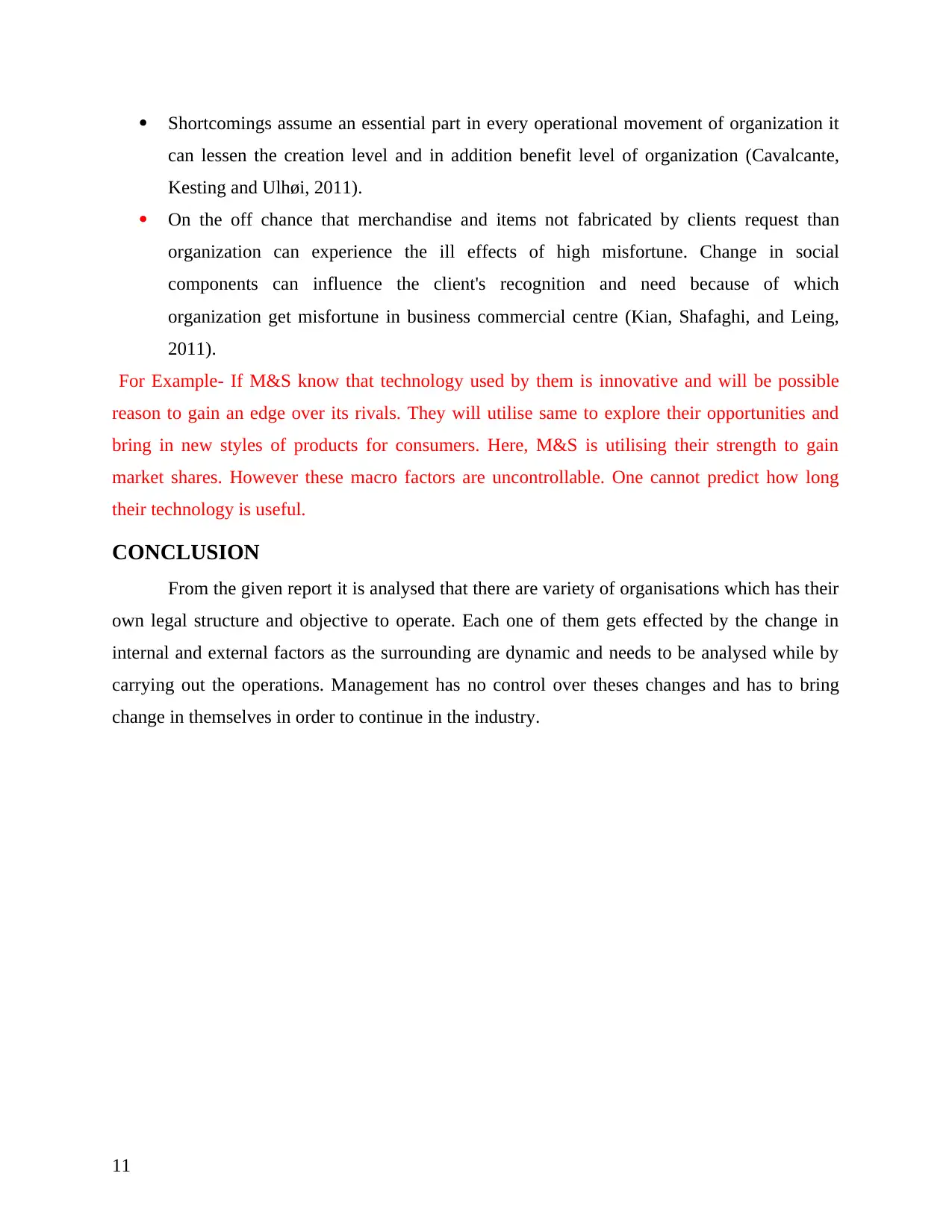
Shortcomings assume an essential part in every operational movement of organization it
can lessen the creation level and in addition benefit level of organization (Cavalcante,
Kesting and Ulhøi, 2011).
On the off chance that merchandise and items not fabricated by clients request than
organization can experience the ill effects of high misfortune. Change in social
components can influence the client's recognition and need because of which
organization get misfortune in business commercial centre (Kian, Shafaghi, and Leing,
2011).
For Example- If M&S know that technology used by them is innovative and will be possible
reason to gain an edge over its rivals. They will utilise same to explore their opportunities and
bring in new styles of products for consumers. Here, M&S is utilising their strength to gain
market shares. However these macro factors are uncontrollable. One cannot predict how long
their technology is useful.
CONCLUSION
From the given report it is analysed that there are variety of organisations which has their
own legal structure and objective to operate. Each one of them gets effected by the change in
internal and external factors as the surrounding are dynamic and needs to be analysed while by
carrying out the operations. Management has no control over theses changes and has to bring
change in themselves in order to continue in the industry.
11
can lessen the creation level and in addition benefit level of organization (Cavalcante,
Kesting and Ulhøi, 2011).
On the off chance that merchandise and items not fabricated by clients request than
organization can experience the ill effects of high misfortune. Change in social
components can influence the client's recognition and need because of which
organization get misfortune in business commercial centre (Kian, Shafaghi, and Leing,
2011).
For Example- If M&S know that technology used by them is innovative and will be possible
reason to gain an edge over its rivals. They will utilise same to explore their opportunities and
bring in new styles of products for consumers. Here, M&S is utilising their strength to gain
market shares. However these macro factors are uncontrollable. One cannot predict how long
their technology is useful.
CONCLUSION
From the given report it is analysed that there are variety of organisations which has their
own legal structure and objective to operate. Each one of them gets effected by the change in
internal and external factors as the surrounding are dynamic and needs to be analysed while by
carrying out the operations. Management has no control over theses changes and has to bring
change in themselves in order to continue in the industry.
11
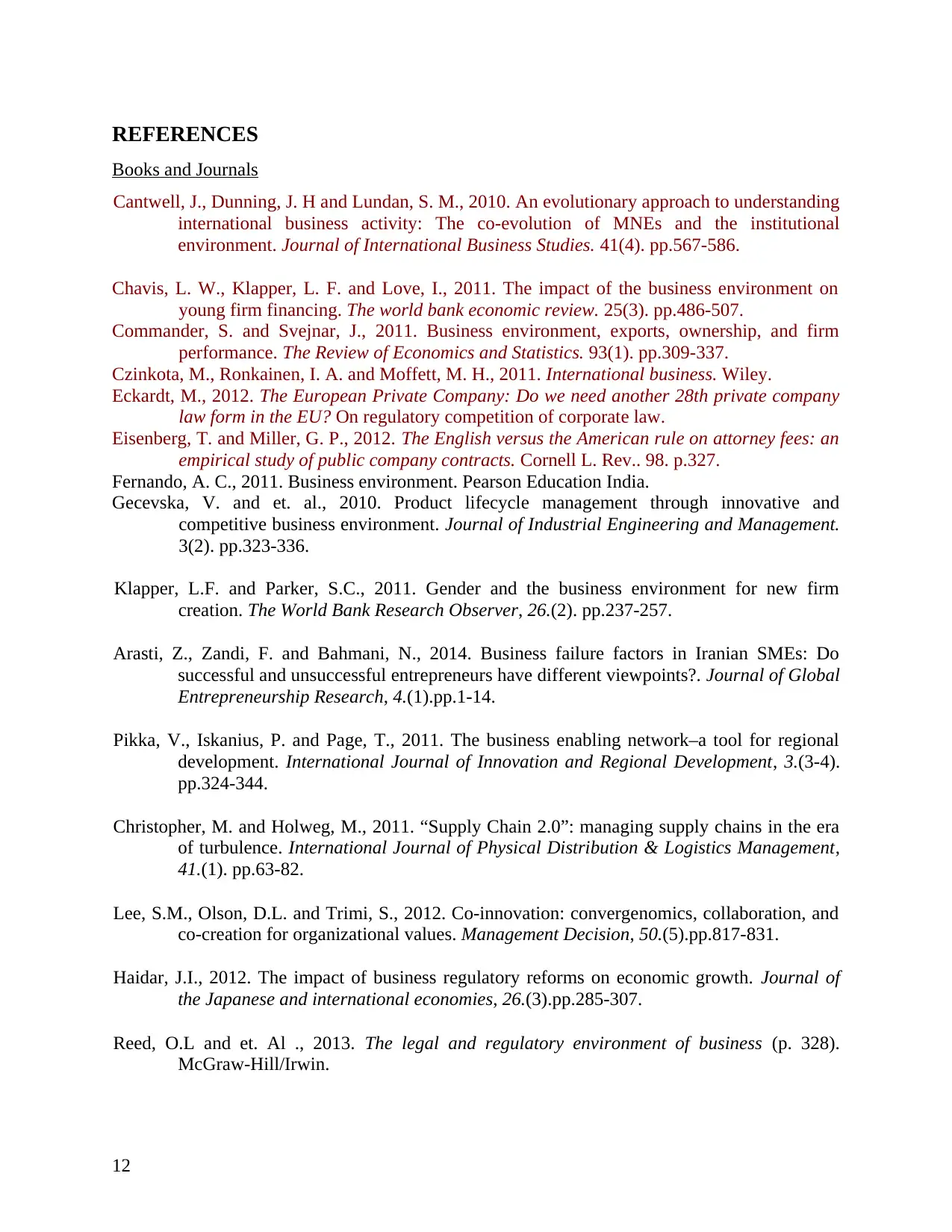
REFERENCES
Books and Journals
Cantwell, J., Dunning, J. H and Lundan, S. M., 2010. An evolutionary approach to understanding
international business activity: The co-evolution of MNEs and the institutional
environment. Journal of International Business Studies. 41(4). pp.567-586.
Chavis, L. W., Klapper, L. F. and Love, I., 2011. The impact of the business environment on
young firm financing. The world bank economic review. 25(3). pp.486-507.
Commander, S. and Svejnar, J., 2011. Business environment, exports, ownership, and firm
performance. The Review of Economics and Statistics. 93(1). pp.309-337.
Czinkota, M., Ronkainen, I. A. and Moffett, M. H., 2011. International business. Wiley.
Eckardt, M., 2012. The European Private Company: Do we need another 28th private company
law form in the EU? On regulatory competition of corporate law.
Eisenberg, T. and Miller, G. P., 2012. The English versus the American rule on attorney fees: an
empirical study of public company contracts. Cornell L. Rev.. 98. p.327.
Fernando, A. C., 2011. Business environment. Pearson Education India.
Gecevska, V. and et. al., 2010. Product lifecycle management through innovative and
competitive business environment. Journal of Industrial Engineering and Management.
3(2). pp.323-336.
Klapper, L.F. and Parker, S.C., 2011. Gender and the business environment for new firm
creation. The World Bank Research Observer, 26.(2). pp.237-257.
Arasti, Z., Zandi, F. and Bahmani, N., 2014. Business failure factors in Iranian SMEs: Do
successful and unsuccessful entrepreneurs have different viewpoints?. Journal of Global
Entrepreneurship Research, 4.(1).pp.1-14.
Pikka, V., Iskanius, P. and Page, T., 2011. The business enabling network–a tool for regional
development. International Journal of Innovation and Regional Development, 3.(3-4).
pp.324-344.
Christopher, M. and Holweg, M., 2011. “Supply Chain 2.0”: managing supply chains in the era
of turbulence. International Journal of Physical Distribution & Logistics Management,
41.(1). pp.63-82.
Lee, S.M., Olson, D.L. and Trimi, S., 2012. Co-innovation: convergenomics, collaboration, and
co-creation for organizational values. Management Decision, 50.(5).pp.817-831.
Haidar, J.I., 2012. The impact of business regulatory reforms on economic growth. Journal of
the Japanese and international economies, 26.(3).pp.285-307.
Reed, O.L and et. Al ., 2013. The legal and regulatory environment of business (p. 328).
McGraw-Hill/Irwin.
12
Books and Journals
Cantwell, J., Dunning, J. H and Lundan, S. M., 2010. An evolutionary approach to understanding
international business activity: The co-evolution of MNEs and the institutional
environment. Journal of International Business Studies. 41(4). pp.567-586.
Chavis, L. W., Klapper, L. F. and Love, I., 2011. The impact of the business environment on
young firm financing. The world bank economic review. 25(3). pp.486-507.
Commander, S. and Svejnar, J., 2011. Business environment, exports, ownership, and firm
performance. The Review of Economics and Statistics. 93(1). pp.309-337.
Czinkota, M., Ronkainen, I. A. and Moffett, M. H., 2011. International business. Wiley.
Eckardt, M., 2012. The European Private Company: Do we need another 28th private company
law form in the EU? On regulatory competition of corporate law.
Eisenberg, T. and Miller, G. P., 2012. The English versus the American rule on attorney fees: an
empirical study of public company contracts. Cornell L. Rev.. 98. p.327.
Fernando, A. C., 2011. Business environment. Pearson Education India.
Gecevska, V. and et. al., 2010. Product lifecycle management through innovative and
competitive business environment. Journal of Industrial Engineering and Management.
3(2). pp.323-336.
Klapper, L.F. and Parker, S.C., 2011. Gender and the business environment for new firm
creation. The World Bank Research Observer, 26.(2). pp.237-257.
Arasti, Z., Zandi, F. and Bahmani, N., 2014. Business failure factors in Iranian SMEs: Do
successful and unsuccessful entrepreneurs have different viewpoints?. Journal of Global
Entrepreneurship Research, 4.(1).pp.1-14.
Pikka, V., Iskanius, P. and Page, T., 2011. The business enabling network–a tool for regional
development. International Journal of Innovation and Regional Development, 3.(3-4).
pp.324-344.
Christopher, M. and Holweg, M., 2011. “Supply Chain 2.0”: managing supply chains in the era
of turbulence. International Journal of Physical Distribution & Logistics Management,
41.(1). pp.63-82.
Lee, S.M., Olson, D.L. and Trimi, S., 2012. Co-innovation: convergenomics, collaboration, and
co-creation for organizational values. Management Decision, 50.(5).pp.817-831.
Haidar, J.I., 2012. The impact of business regulatory reforms on economic growth. Journal of
the Japanese and international economies, 26.(3).pp.285-307.
Reed, O.L and et. Al ., 2013. The legal and regulatory environment of business (p. 328).
McGraw-Hill/Irwin.
12
⊘ This is a preview!⊘
Do you want full access?
Subscribe today to unlock all pages.

Trusted by 1+ million students worldwide
1 out of 13
Related Documents
Your All-in-One AI-Powered Toolkit for Academic Success.
+13062052269
info@desklib.com
Available 24*7 on WhatsApp / Email
![[object Object]](/_next/static/media/star-bottom.7253800d.svg)
Unlock your academic potential
Copyright © 2020–2025 A2Z Services. All Rights Reserved. Developed and managed by ZUCOL.





